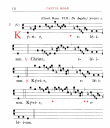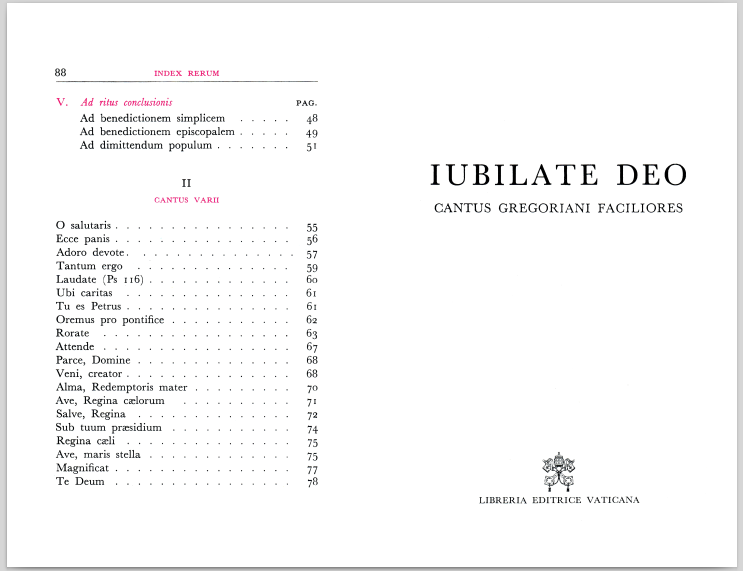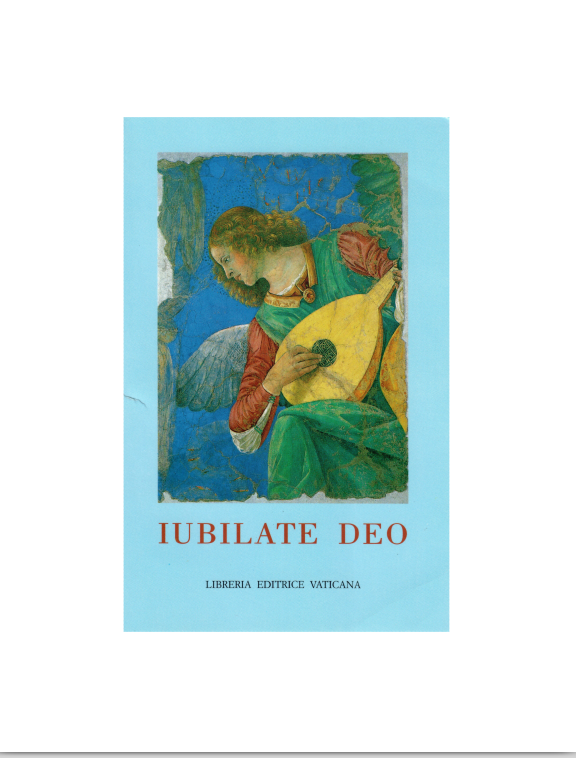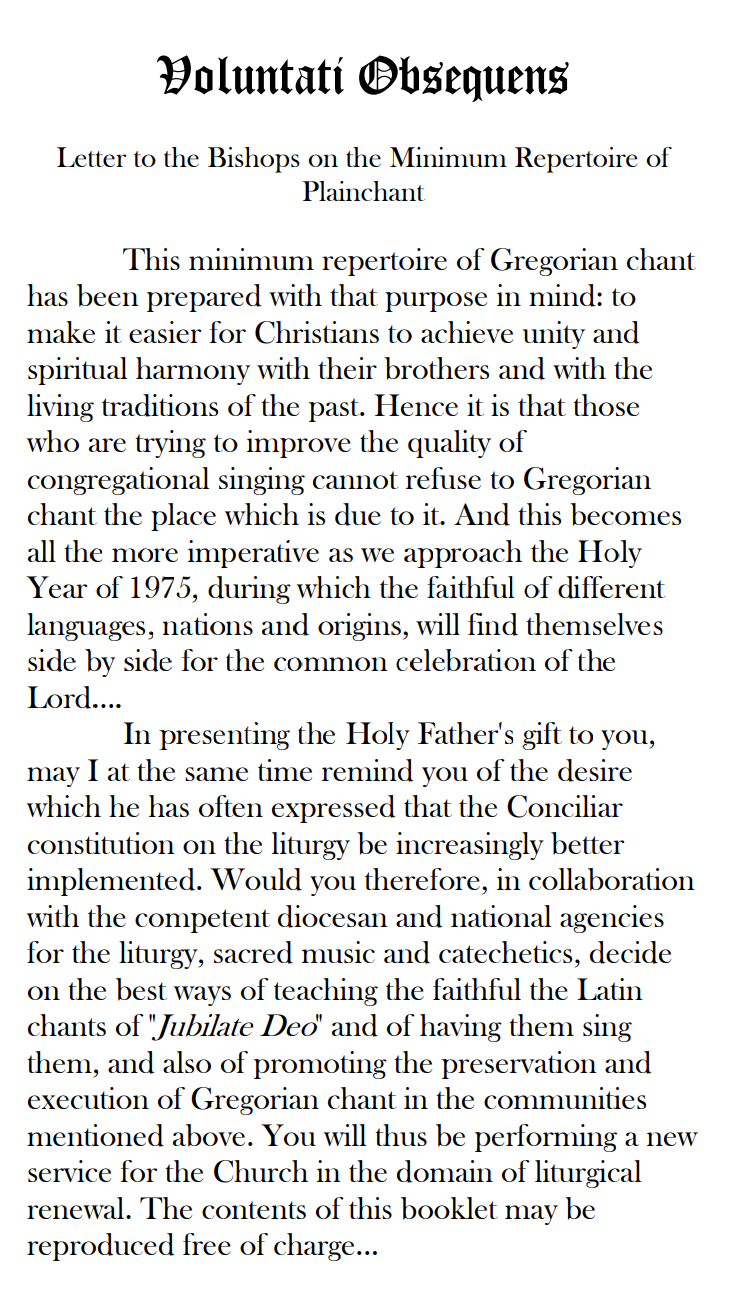I've made scans of Jubilate Deo (2nd ed. 1999) and they're available for download
-
Recently I bit the bullet and cut up and scanned a copy of the 1999 printing of Jubilate Deo, since the booklets themselves are incredibly hard to come by, and scans of it seem nowhere to be found. I have two different formats (both PDF) on my google drive (both are about 110 MB in size). I've attached a screen cap of a partial page to give you some confidence that I'm legit.
I've done this because it seems clearly the will of the Church that these chants be made widely and freely available. I also have had a translation made of the introduction of the second edition (the translated intro of the first edition is widely available).
I hope some of you find this helpful!
Mike
https://tinyurl.com/JubilateDeoScans
 Jubilate Deo Screen Capture.png1010 x 1172 - 795K
Jubilate Deo Screen Capture.png1010 x 1172 - 795K -
This is wonderful! And I had no idea there was a second edition -- much expanded from the first!
-
For those who, like me, had no idea what saddle stitch is:

And this is half page:

 HalfPage.png576 x 758 - 302K
HalfPage.png576 x 758 - 302K
 saddle-stitch.png743 x 571 - 79K
saddle-stitch.png743 x 571 - 79K -
Saddle stitch is meant to be printed double sided and then assembled into a booklet. Since there are 88 pages in the booklet, and each page of paper holds 4 pages of the booklet, that means 22 printed pages for the entire booklet. Printers will print and staple saddle stitch booklets for a price.
-
And I had no idea there was a second edition -- much expanded from the first!
Very good evidence to demonstrate to a pastor or music minister that the Church is serious about retaining Gregorian Chant (99% of parishes notwithstanding). -
I found a copy on the Vatican Bookstore website a few years back. I had to search for a while before finding it (don't remember which search terms I used to finally find it).
-
So this is not under copyright?
-
I think here we are in a weird situation in which all the chants are in the public domain, but the engravings are considered proprietary.Thanked by 1RedPop4
-
Correct me if I'm wrong, but didn't the Vatican give permission for this booklet to be freely duplicated in order that the chants contained in it be more widely available? At least that was my understanding reading Paul VI's letter to the bishops when he published the original version.
-
Regardless, the chants ARE in the public domain, and you can get them straight off of Gregobase without having to code them in, so you can recreate any portion of this booklet in a matter of minutes perfectly legally.
-
Indeed, the very last sentence gives permission for the contents of the booklet to be reproduced free of charge.


 JubilateDeo.png748 x 1316 - 320K
JubilateDeo.png748 x 1316 - 320K -
One could, technically, quibble over "contents" and "engraved impressions" are the same thing (a bit like saying, "you can use this music freely, but not this recording of said music"). Regardless, what is contained therein (the music itself) is certainly public domain, whether the vatican wanted it to be or not.Thanked by 1tomjaw
-
Exactly, permission is given to reproduce the contents free of charge (and this is not revoked in the 2nd edition). To quote from the US Copyright Office: "Copyright also provides the owner of copyright the right to authorize others to exercise these exclusive rights..."Thanked by 1tomjaw
-
In some countries, i.e. much/all of continental Europe) you can't put something in the public domain yourself, and free use is nonexistent (widely ignored, of course, in our day and age), so the pope's statement was necessary to avoid as many questions as possible. In fact, the CC-0 license was created for much the same reason.
(As an aside, I'm still not sure if droits d'auteur or copyright is the better regime (both have significant pros and cons from a classical legal perspective, but it is what it is…)Thanked by 1tomjaw -
Thank you, this is good to have, especially at such high resolution. Just one issue I noticed -- in the saddle stitch version, there is no p 63, and page 67 seems to be there twice (in its correct place, and in place of p 63). The half page version appears to be fine.
-
Oops! I'll look into that, thanks!
-
OK, I fixed the saddle stitch file (page 63 is now correct).Thanked by 1JonLaird
-
Thank you for scanning and posting this. Very helpful.
Welcome to the MusicaSacra Forum!
To participate in the discussions on Catholic church music, sign in or register as a forum member, The forum is a project of the Church Music Association of America.
Categories
- All Discussions21,104
- General Music Discussion8,217
- Job Openings197
- Management of Music Programs850
- Choral Matters533
- Church Documents and Rubrics524
- CMAA Notes302
- Events716
- For Newcomers: Read First26
- Sacred Polyphony546
- Hymnody872
- Gregorian Chant: General2,697
- ↳ Graduale Romanum and Liber Usualis368
- ↳ Graduale Simplex60
- ↳ Semiology63
- Vernacular Plainsong696
- Anglican Use and Anglican Chant68
- Organ, Other Instruments and Repertoire435
- New Composition/Works in Progress1,290
- Recordings230
- Music for Hispanic Ministry159
- Music Education: Children211
- Music Education: General222
- News Items245
- Positions Wanted2
- General Discussion: Catholicism739
- Amusements177
- General Discussion1,033
- Opinions117

